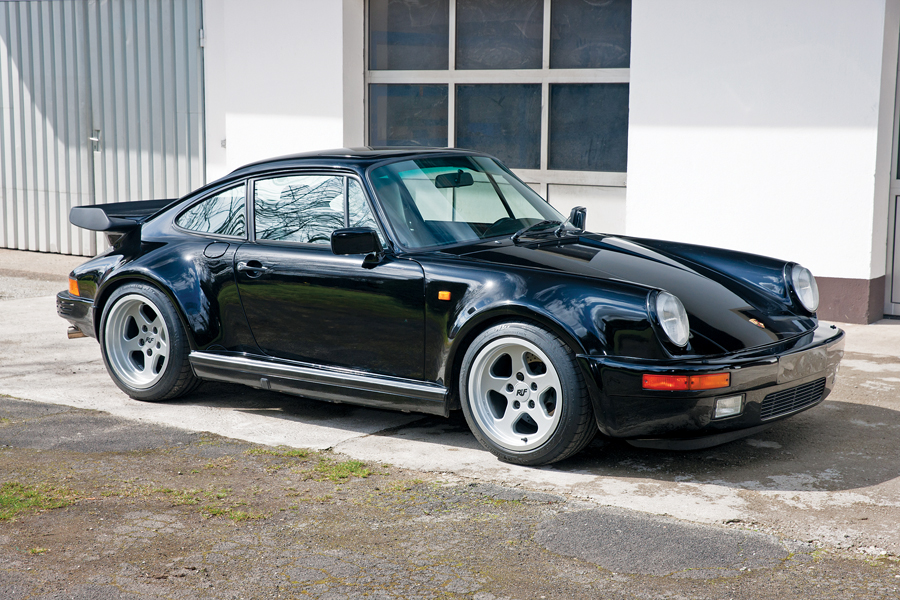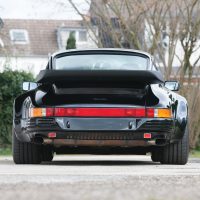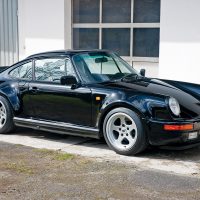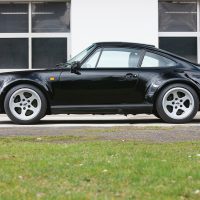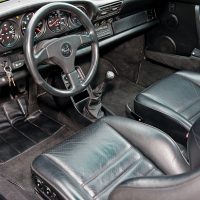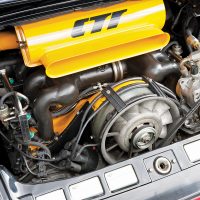SCM Analysis
Detailing
| Vehicle: | 1988 Porsche 911 Turbo / RUF-Converted CTR |
| Years Produced: | 1987–92 |
| Number Produced: | 29 factory-built and numbered cars. There are an estimated 30 to 100 conversions of customer-owned Porsches |
| Original List Price: | $223,000 |
| SCM Valuation: | Median to date, $203,000; high sale, $330,000 |
| Tune Up Cost: | $3,200 |
| Chassis Number Location: | Tag at base of windshield, inside passenger’s side fender wall |
| Engine Number Location: | On small flat boss front, top right of engine |
| Club Info: | Porsche Club of America |
| Website: | http://www.pca.org |
| Alternatives: | 1989 Porsche 959 Sport, 1992 Porsche 964 Turbo, 1984–85 Ferrari 288 GTO, 1985–91 Ferrari Testarossa |
| Investment Grade: | B |
This car, Lot 213, sold for €224,000 ($256,646) at RM Sotheby’s Monaco Auction on May 14, 2016.
The factory-built RUF CTR is a rare, desirable collectible variant of a Porsche. However, factory or licensee conversions of customer-owned cars face a less heady market. The RUF plant in Pfaffenhausen, west of Munich, built just 29 of their RUF serial-numbered CTRs, and many 911 collectors either have one or want one. Two highly publicized events took place in 1987 and 1989 that made the CTR an automotive icon.
Twin epochal events
The first was that Road and Track sensed that time was ripe for a follow-up to their 1984 “Fastest Car in the World” test, won by an earlier RUF BTR at 184 mph. They arranged the second one for April 1987 at Volkswagen’s test track in Ehra-Lessien in northern Germany. That facility was the ultimate oval track: 15.5 miles around, with two seven-mile straightaways connected by a pair of high-banked turns. Assembled for R&T writer Peter Egan and photographer John Lamm were nine supercars. Together with their basic specs and performance results, they are listed in the accompanying chart below.
The Yellowbird breaks out
Already dubbed “Yellow Bird” (originally two words) by the RUF engineers, Paul Frere drove the twin-turbo, narrow-bodied RUF CTR prototype to 209 mph, handily breaking the 300-kph and 200-mph speed barriers that are important in Europe and the United States. Egan wrote in his July 1987 article in R&T: “Paul looked over at me with a slightly manic grin and shouted over the earsplitting roar of the engine, ‘This is the fastest I have ever gone in my life!’ Not the kind of thing you hear from a former Grand Prix driver and Le Mans winner who test drives almost every conceivable kind of car for a living.”
Later in the afternoon, Phil Hill drove the CTR with John Lamm riding shotgun and hit 211 mph through the speed traps. That run set a new world’s record for a “production” car. Phil Hill added this perspective: “I can’t forget the last RUF car we drove for top speed in our previous fastest cars story. It was the quickest, but it was also skitterish and a little scary, but the new one is just steady as a rock — and it’s about 39 km/h faster. I must say it is pretty extraordinary to take a car you can drive on the street and go this fast. How fast is 339 kilometers per hour in miles per hour? Two-ten or so? Amazing.”
Later, Auto, Motor und Sport conducted a high-speed test at Nardo Ring, where the CTR logged 213 mph, but why quibble? The Yellowbird’s record at Ehra-Lessien stood for 18 years until a Bugatti Veyron broke it in 2005, with 10 more cylinders, twice the horsepower, and five times the price, but it did 253 mph. Coincidentally, in street mode, the Veyron’s top speed was 213 mph. To get to the 253 mph top speed, the driver had to select a mode that lowered ride height, closed air inlets, and lowered the rear spoiler.
“Faszination on the Nürburgring”
The second event occurred in 1989, when RUF took that same Yellowbird (now one word) to the Nordschleife of Nürburgring and set a record run of eight minutes, five seconds, a record later also broken by a Veyron. The two-lap videotape of RUF’s test driver Stefan Roser, titled “Faszination on the Nürburgring,” went viral. Roser’s slides were lurid, steering wheel everywhere but straight, tires wailing, pushing out plumes of white smoke. The run has logged millions of views on YouTube.
What was a CTR?
Alois Ruf (senior) founded Auto Ruf, a service and repair shop, in 1939. It migrated to become a bus manufacturer in the 1950s, and finally a Porsche tuner in the early 1960s. His charismatic son, Alois Ruf (junior) took the helm at age 24 in 1974. Thereafter, he concentrated on his passion — Porsche 911s.
Under the young Ruf, the firm progressed and was recognized in 1981 by the German government as an automobile manufacturer. Thus, Ruf could assign his own unique serial numbers. U.S. certification followed in 1988, but supposedly only one new CTR came to the States, in 1989 — with the unusual serial number 9111111097. For many years, Porsche treated Ruf as a good partner and he was able to buy bodies, engines and sub-assemblies from Stuttgart. He was even awarded subcontracts by the Sonderwunsch/Exclusive Department. Porsche’s attitude ultimately changed, but by then Ruf was very well established.
The RUF CTR was based on the standard Porsche Carrera narrow-body, normally aspirated 3.2-liter 911, not the 930 Turbo, as one might imagine. Ruf wanted a lighter car and the narrow body for better aerodynamics. To further lighten the car, Ruf deployed aluminum doors, hood and engine lid — the latter with a lightweight flat SC/RS-style tail. Ruf added fiberglass bumpers, presaging the 964 look; rain gutters were shaved off; and NACA-like ducts were added to the rear fenders to feed air to the twin turbos. (Those ducts actually sucked air out of the engine compartment and were eliminated on later CTRs.)
To help stiffen the tub, a full roll cage was integrated into the spartan RS-like interior. A 1972 911-style outside oil filler was used because the oil tank had to be relocated to accommodate one of the intercoolers. The suspension was up-rated, and the rear fenders were widened slightly to accommodate lightweight 17-inch Speedline wheels carrying Dunlop Denloc tires. The brakes were 13-inch Brembo four-piston units. The CTR weighed in at more than 400 pounds lighter than a Factory 930.
The engine was modified with larger-bore pistons and cylinders to move up to 3,367 cc, with a Bosch Motronic ignition similar to that of the Porsche 962 race cars. There were two large turbochargers, twin intercoolers, and the typical huge RUF yellow air cleaner on top. To Road and Track, RUF specified output at 469 horsepower. Later specs read 496 horsepower, while rumors suggested up to 550, with 457 foot-pounds of torque.
Ruf makes his own gearbox
The gearbox was custom-made by Ruf. Until the 1989 models adopted the G50 5-speed gearbox, the curse for 930 owners had long been the 4-speed gearbox, the only one deemed sufficiently strong by Porsche to handle the power of the turbocharged engine. Ruf circumvented that problem by building his own 5-speed box. He also specified his own gearing with the 300 kph and 200 mph targets in the design specs. A year or two later, Ruf began to make his own 6-speed gearbox.
If you study the accompanying chart derived from the Road and Track test, you will see that Ruf wisely concentrated on weight to horsepower. The RUF Yellowbird had the second-best ratio among the nine R&T test cars, excepting only the Koenig/RS.
What was our auction car?
The car auctioned by RM Sotheby’s in Monaco on May 14 was one of the less valuable RUF-modified, customer-owned Porsches. It was not one of the 29 RUF factory-built CTRs. Furthermore, this one was built out of a 1988 930, so it lacked the narrow body of a “real” CTR, which is something aficionados consider essential. Early in its life it was converted to the less-advanced BTR specification with 375 horsepower and a top speed of 185–190 mph. In 1992, its owner asked RUF to convert the car again, this time to CTR specs.
Ruf reportedly lost his records in a fire, but my RUF-oriented buddies think that from 30 to perhaps as many as 100 Carreras and Turbos were converted. Regardless, the market puts a premium on the 29 factory-built cars, which typically sell at about $500,000 in America and reportedly up to €700,000 in Europe.
What does this say about the $256,646 realized at Monaco, including the buyer’s premium? I think that is a matter of collecting philosophy. Is it better to save 50% or even 75% and still get some bragging rights? Perhaps yes — until someone queries the Turbo flares or asks to see the serial number. ♦
(Introductory description courtesy of RM Sotheby’s.)
